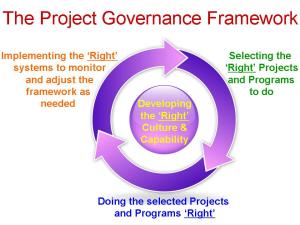One of the themes running through several of my recent posts is the importance of effective Governance. Both organisational governance and its sub-set project governance.
Good governance is a synonym for ‘good business’, structuring the organisation to deliver high levels of achievement on an ethical and sustainable basis. This requires the optimum strategy and the right approach to risk taking supported by sufficient processes to be reasonably confident the organisations limited resources are being used to achieve the best short, medium and long term outcomes.
Project governance focuses on the portfolios of programs and projects used by the organisation to deliver many of the strategic objectives. This process focuses first on doing the right projects and programs constrained by the organisations capacity to undertake the work – Portfolio Management; secondly, creating the environment to do the selected projects and programs right- developing and maintaining an effective capability; and lastly systems to validate the usefulness and efficiency of the ongoing work which feeds back into the selection and capability aspects of governance.
Within this framework, portfolio management is the key. Strategic Portfolio Management focuses on developing the best mix of programs and projects to deliver the organisations future within its capacity to deliver. This means taking the right risk and having sufficiently robust system in place to identify as early as possible the ‘wrong projects’, so they can be either be reframed or closed down and the resources re-deployed to other work.
It is impossible to develop an innovative future for an organisation without taking risks and not every risk will pay off. Remember Apple developed the ‘Apple Lisa’ as its first GUI computer which flopped in the market, before going on to develop the Apple Macintosh which re-framed the way we interact with machines.
Obviously no organisation wants to have too many failures but good governance requires ‘good risk taking’. Apple had no guarantees the i-Pod and its i-Tunes shop would succeed when it started on the journey of innovation that has lead to the i-Phone, i-Pad and Apple becoming one of the largest companies in the world based on capitalisation. As Richard Branson says – ‘you don’t bet the company on a new innovation’ but if you don’t innovate consistently, obsolescence will be the inevitable result.
The balance of project governance focuses around creating the environment that generates the capability to deliver projects and programs effectively, effective sponsorship, effective staff development, effective and flexible processes and procedures, simple but accurate reporting and good early warning systems to identify issues, problems and projects no longer creating value (a pharmaceutical industry saying is that if a project is going to fail it is best to fail early and cheap!).
Good questions outrank easy answers! Every hour and dollar spent on governance processes is not being spent on developing the organisation. The challenge of good governance is to have just enough reporting processes embedded in an effective culture of openness and accountability to provide an appropriate level of assurance the organisation’s resources are being used effectively; whilst at the same time allowing innovation and development. Restrictive and burdensome governance processes are simply bad governance – they restrict the organisation’s ability to achieve excellence.
To help organisations understand these key governance processes we have updated our two White Papers on the subject:
Corporate Governance: http://www.mosaicprojects.com.au/WhitePapers/WP1033_Governance.pdf
Project Governance: http://www.mosaicprojects.com.au/WhitePapers/WP1073_Project_Governance.pdf
For more discussion around the subject of governance see the previous posts on this blog.




An excellent and simple summary of one of the major issues facing companies of all sizes. Most companies will even admit that they are weak in this area, yet for a number of reasons: political, cultural, budget (both capital and resource), too many other challenges etc, fail to implement a solution. Only when the pain becomes great or management drives it, does change happen, sometimes too little or too late…
I particulary like the focus on a central (physically located in the middle) culture of the organisation. Politics tends to derail some initiatives and it can infect the culture of the organisation. When this happens, each of the “spokes” (right projects, in the right way, with the right systems) get affected and this makes for interesting effects. Often, this kicks off a swinging pendulum of action and counter-action (much like Newton’s 3rd law: “for every action there is an equal and opposite reaction…”) that results in watsed effort, resources, funds.